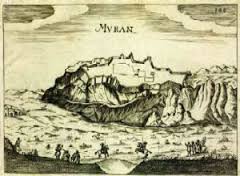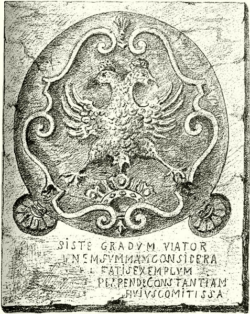Murány

Murány Castle (Muránsky Hrad) was perhaps the most formidable of all the forts in the Upper Lands of the Hungarian Kingdom because it is situated on the steepest and highest cliffs of the Carpathian Mountains. It can be found in Slovakia, in the lands that Slovakians call Horná zem, and Hungarians call Felvidék. It is famous for Lady Széchy Mária, the “Venus of Murány”.

The place was first mentioned in 1271 when King István V gave it to Comes Gunig. This means that the castle was probably built right after the Mongolian invasion in 1241-42. The Ilosvai family owned it in the 13th century and the Bebek family seized it from them around 1401. We know that the village under the castle was called Murányalja and that it was paying taxes for 24 houses in 1427.
It was King Zsigmond who affirmed this ownership of the Bebek of Pelsőc family by giving the taxing places of Murány and the castles of Jolsva and Fülek to them in 1435. Legend says that they were the ones who built the stone castle on the rock, while others say that the castle was built by the Ilsva (Ilosvai) family, or by the Czech Jan Giskra.

It is true, that Hungarian Queen Elisabeth of Luxemburg gave Murány, among other castles, to the Czech robber knight and mercenary leader Jan Giskra. As for the Hussites, they indeed built some forts during their stay. It was Szapolyai István, the commander of King Matthias’ army, who took Murány Castle back for the king. The Tornallyai family owned it around 1500, then, we found it in the Habsburg king’s hands in 1549.
1556: Unlucky Turkish raid next to the castle of Murány
It was in December 1556, that a Turkish raiding party met with bad luck near Murány Castle. Something unusual happened in the winter of 1556. The Turkish raids didn’t stop even after the first frosts and snowfalls. Among the raiders, some Turkish irregulars attacked the castle of Murány. However, Captain Dominics Gáspár gave them a severe beating. On 3 December 1556, the captain sent a letter to King Ferdinand reporting his victory. He also sent four Turkish flags, sixty noses, and a captured captain of the pillagers. Dominics wrote to the king that the captain had done much harm to Christians and should not be pardoned but sent back to be impaled. King Ferdinand, as usual, was pleased to receive the noses. It is a pity that in his grateful reply to Dominics, the King did not mention what he had done with the sixty noses of the bandits. The King should have mentioned it for our sake.
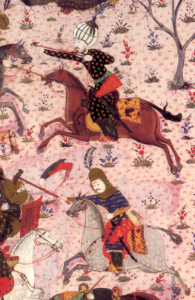
Murány and the Széchy family
As the Royal Court was always in need of money, Murány was offered for sale to Prince Rákóczi Zsigmond for 40,000 gold Forints in 1600. But then, Johann Rottal, the Chief Advisor of Hungarian Affairs in the Secret Council of the King, took the transaction into his hands. Finally, Murány landed in the hands of Baron Jakab in exchange for 100,000 gold Forints. There was a huge domain attached to the castle, so the Court decided to buy it back in 1608, according to a decision of the Diet from the same year. As the king had no money, the next year a wealthy Hungarian aristocrat, Széchy Tamás paid Baron Rottan a token amount to acquire Murány Castle and its lands.

The heyday of the castle began with the Széchy family. Széchy Tamás had a son, György, but instead of the castle going to him, the ownership went to his wife Homonnay Mária. Later, Mária purchased it from her father-in-law. She and Széchy György made Murány one of the most important centers of the Protestant spirit and culture in 1613. (Please note, I use the Oriental name order for Hungarians where family names come first.)
Széchy György opposed both the Catholic King Ferdinand II and the Protestant Prince Bethlen Gábor of Transylvania knowing no lord over himself. When he suddenly died in 1625, the castle’s ownership had reverted to the king. However, his widow bribed the Viennese court with 22,000 gold Forints so she could become the castle’s owner again. She had to swear an oath that neither she nor her heirs would ever yield it to the Transylvanian princes or anybody on their side.

She received the king’s approval in 1626. Before her death, the relentless mother forced her daughter, Széchy Mária, to give up her rights in favor of her sisters and their husbands. Maria went to court against her mother, but nothing could be done. When the strict widow died all of her daughters took the side of Prince Rákóczi despite their mother’s oath. As it turned out, in the 1630s, two daughters owned the castle, Éva, and Kata. Maria was just a barely tolerated person when she stayed there as you will read.

Széchy Mária, the “Venus of Murány”

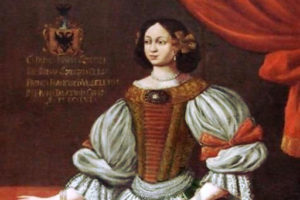
The famous legend of Murány tells the story of how Széchy Mária tricked everyone and gained the castle for her fiancée, Wesselényi Ferenc in secret. She was about 34 at that time and getting married to Wesselényi was the only way to get the ownership of Murány castle back from her greedy sisters. Wesselényi happened to be on King Habsburg Ferdinand’s side, so this was how the fort returned to the king on 5 July 1645 without him having to pay or fight for it. The adventure of how Lady Mária made the guards drunk and how she prepared rope ladders for the men of Wesselényi, is perhaps one of the most exciting love stories of the 17th century. I wrote more about this legend in my book “33 Castles, Battles, Legends”, which is available in ebook and paperback on Amazon:

Wesselényi had been a talented and valiant, but not very rich nobleman. He was the Captain of Fülek Castle, not very far from Murány. He was eager to get acknowledged before his king and the taking of Murány castle was such a deed that he needed. His castle, Fülek was not very far from Murány. You can read more about Fülek (Filakovo) castle on my page:
https://www.hungarianottomanwars.com/kingdom-of-hungary/fulek/

However, when he wed Széchy Mária he became prosperous and his career rose higher and higher. Eventually, he was appointed as Palatine of Hungary, the second person in rank after the king. He had been fighting against the Ottoman Turks all his life. But when the great poet and general, the Hungarian-Croatian Count Zrínyi Miklós died in 1664 (some say because of the assassination of the king), Wesselényi became deeply disappointed in regard the Habsburg’s good intentions about saving Hungary.
He organized a conspiracy against the Court in which almost all of the highest aristocrats were involved. Sadly, they were betrayed and his friends were executed. Wesselényi died in 1667 before his trial. After this, Száchy Mária hurried to give up the members of the Conspiracy, similarly to the other members who betrayed the case. From the movement’s point of view, however, Széchy Mária’s action was more damaging than anyone else’s, because she of her own volition – even if she yielded to pressure from her companions – gave up her collaborators long before the lawsuits were launched, when she was not yet in imminent danger.
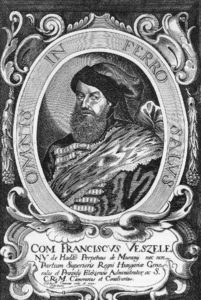
After his death, the king wanted to take away his possessions. But Lady Maria would not give Murány Castle up so easily. Duke Charles V of Lotharingia had to bring his army and lay a proper siege on it in 1672. Széchy Mária was personally leading the defenders. But despite how heroically she fought, she had to surrender the fort. Then, she had to leave Murány Castle and died in 1679 whilst in exile in Kőszeg. Duke Charles found certain documents in Murány castle that revealed many details of the earlier conspiracy. The Court did its best to take revenge on the Hungarian noblemen of Royal Hungary, regardless of their involvement. This led to growing restlessness and later to the so-called Kuruc rebel wars of Prince Thököly Imre and Prince Rákóczi Ferenc II in the following decades.

During the new Habsburg-Hungarian conflicts, Murány Castle changed hands often between the Imperial forces and Thököly’s men. There was a great fire in 1702 which caused severe damage to the castle. Bercsényi Miklós, the famous general of Prince Rákóczi Ferenc II, took the fort in 1706 and considered it safe enough to guard the Holy Crown of Hungary within its walls. After the end of Rákóczi’s War of Independence, Murány lost its strategic role and the Habsburg King Charles III gave it to Count Koháry in 1720. At least, this stronghold was not exploded by gunpowder because of the fear of the rebellious Hungarians.

Dear Readers, I can only make this content available through small donations or by selling my books or T-shirts:
Please, feel free to support me with a coffee here:
You can check out my books on Amazon or Draft2Digital, they are available in hardcover, paperback, or ebook:
https://www.amazon.com/dp/198020490X or at https://books2read.com/b/boYd81

My work can also be followed and supported on Patreon: Become a Patron!http://Become a Patron!
[wpedon id=”9140″]

https://hungarianottomanwars.myspreadshop.com/all

Here are a few pictures of Murány Castle:








